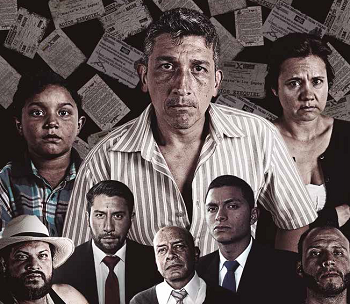Multiple recent assassinations of Colombian human rights defenders are adding to concerns that criminal organizations are attempting to eliminate potential civilian adversaries, a trend that could disrupt the successful implementation of a peace deal with the country’s main guerrilla group.
On the morning of September 6, Cecilia Coicué left her house in the rural municipality of Corinto in the department of Cauca to check on a water source, El Espectador reported. By the next morning, she still had not returned. The 62-year-old’s body was later found riddled with multiple stab wounds.
Coicué, a member of the political movement Marcha Patriótica (MP) and various social and agricultural associations, reportedly owned a plot of land in which guerrilla fighters of the Revolutionary Armed Forces of Colombia (Fuerzas Armadas Revolucionarias de Colombia – FARC) will demobilize in the coming months. The land is one of the eight encampments in which FARC members will gather following the signing of a final peace deal with the Colombian government.
SEE ALSO: Coverage of the FARC Peace Process
Coicué’s apparent murder was the most recent in a string of assassinations of community leaders that have occurred in southwest Colombia over the past few weeks.
On August 29, reports emerged that three people were killed in the Cauca municipality of Almaguer. One of the victims, Joel Meneses, was a long-standing indigenous community leader, according to W Radio.
On September 5, authorities reported another deadly attack in Cauca that left one person gravely injured and three more dead — two of whom were burned inside their own home.
Despite the decrease in violence related to the decades-long conflict between the FARC and the government, concerns remain about a surge in attacks against social leaders and human rights defenders, most of which have been attributed to criminal groups.
Colombian human rights organization Programa Somos Defensores reported that between 2010 and 2015, 346 human rights defenders have been killed (pdf). Between 2014 and 2015, murders of activists rose 13 percent, and during the first six months of 2016, there were 35 killings (pdf). According to the organization, the departments of Cauca, Antioquia, Valle del Cauca, Nariño and Norte de Santander are the most affected. (See Somos Defensores’ graphic below)

Map taken from a 2016 Programa Somos Defensores report (pdf)
InSight Crime Analysis
The rising number of attacks against human rights defenders and community leaders could be related to armed groups looking to protect existing criminal economies or move into new ones — a trend that is intensifying as the FARC prepare to move out of territories they have controlled for decades. Recent reports suggest that in areas where local leaders are being targeted for assassination, illegal armed groups are working to establish control of the drug trade and illegal mining, among other illicit activities. (See Somos Defensores’ graphic below)

According to Mauricio Redondo, a former human rights official in Cauca, the security situation in that department has been more stable since the FARC declared a unilateral ceasefire in December 2014. Nevertheless, a desire for control over criminal economies such as illegal mining could be putting local citizens in danger.
In order to further their illicit activities, criminal groups are willing “to attack the community and those who represent it, and those who speak out in defense of the land,” Redondo told InSight Crime.
Meneses, the late community leader from Almaguer, belonged to an organization that campaigns against the illegal exploitation of minerals, which is likely why he was targeted. Human rights observers have reported (pdf) that other anti-mining activists have also been threatened in Cauca this year.
Redondo stated that there is no concrete evidence pointing to the specific groups that may be responsible for targeting such activists, but there is a known presence of various criminal groups known as BACRIM in the area. There are also reports that the country’s second largest guerrilla group, the National Liberation Army (Ejercito de Liberacion Nacional – ELN), has been engaged in gold mining activities, protecting them by force in areas such as Almaguer, where Meneses and two others were killed.
Somewhat paradoxically, the peace process with the FARC could be putting activists at risk. In the northern departments of Córdoba and Norte de Santander, social leaders have been threatened for their work in support of the peace deal.
“We’re supporting the [part of the peace] agreement regarding victims, and in many areas where there is no state presence there are a lot of people against the [peace] negotiations,” Alberto Rojas, a representative for the displaced population in Norte de Santander, told La Silla Vacía. “We don’t know for sure who is behind it, but various [community] leaders have already had to leave the hamlets due to threats or extortion.”
SEE ALSO: Coverage of Human Rights
Carlos Guevara, a member of Programa Somos Defensores, has also highlighted the dangers facing activists based in the designated areas where FARC members will be demobilizing due to their perceived ties to the guerrilla group.
“All eyes will be on making sure that nothing will happen to the guerrilla movement, but violence against [community] leaders in these territories due to stigmatization will surely intensify after the FARC lay down their weapons,” Guevara told El Espectador.
The threats and attacks against community leaders perceived to be associated with the FARC bring to mind grim memories of a previous attempt by the guerrilla group to transition from the military to the political realm.
Following a ceasefire agreement in the 1980s, members of the FARC joined with other leftists to form a political party known as the Patriotic Union (Unión Patriótica – UP). However, right-wing paramilitary groups massacred thousands of the party’s members, which led to the dissolution of the ceasefire and nearly three more decades of civil war.
It is possible that the failure to protect a new generation of left-wing leaders and politicians from violent retaliation could once again push former guerrillas to rekindle their military struggle.

